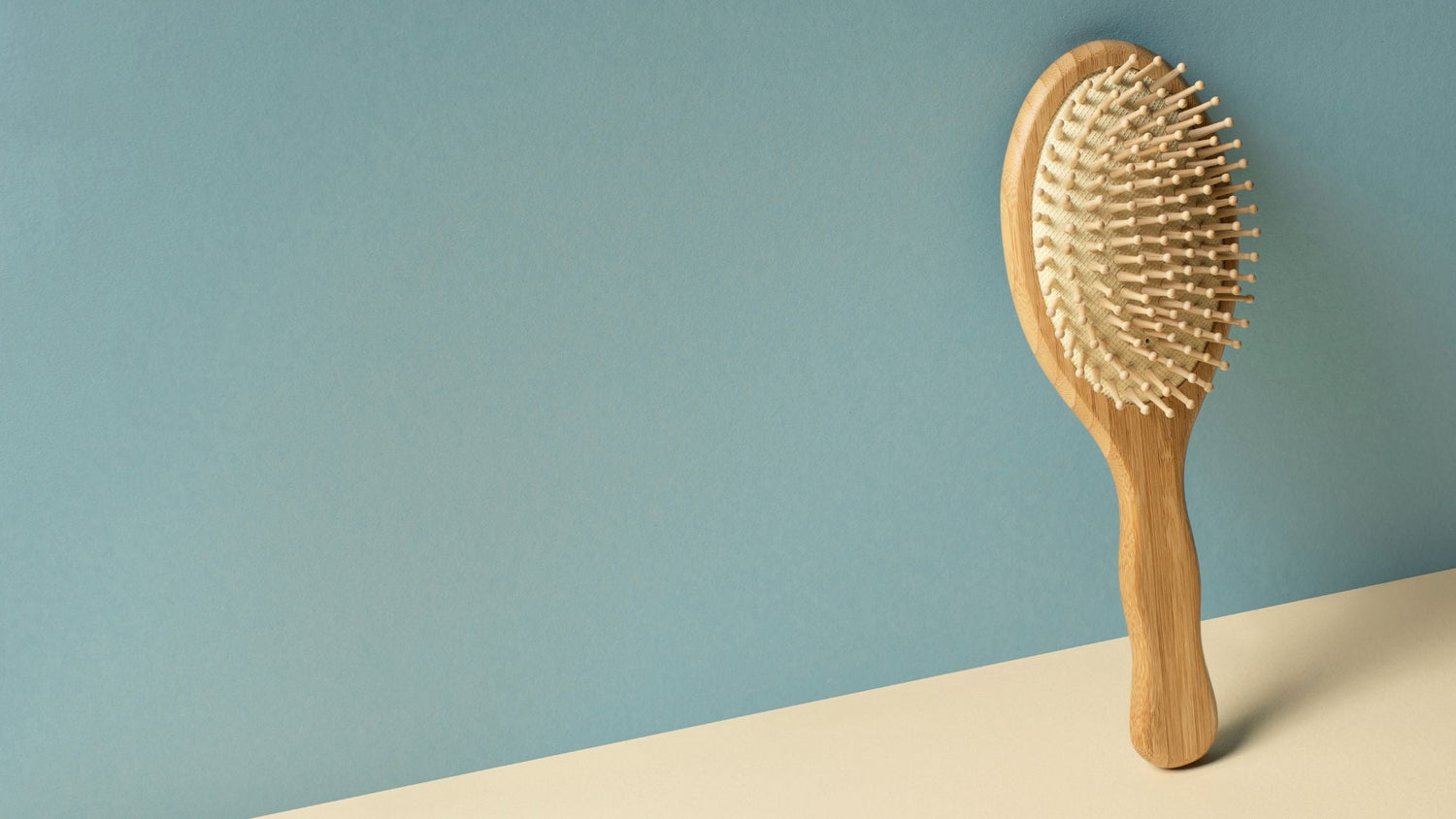Few compounds have generated as much intrigue in their potential for hair growth as spermidine. This little-known polyamine molecule, with its origins tracing back to the microscopic world of cellular biology, has emerged as a game-changing, natural antidote to hair loss and gray hair.
What is Spermidine?
Spermidine is a naturally-occurring polyamine that is present in all living things, including plants! In terms of food sources, it is most abundant in wheat germ, soy beans, cheese and shiitake mushrooms.
In the past decade, spermidine has generated a lot of interest as a potent promoter of longevity. An abundance of research has proven spermidine’s ability to induce autophagy (the body's vital cellular "clean up" process that slows with age), reduce oxidative stress and inflammation, and as a result, delay aging and increase healthspan in humans. Mainly due to its ability to activate autophagy [1], spermidine is thought to inhibit 9 of the 12 root causes of aging, known as the "hallmarks of aging".
The Origins of Spermidine
The origins of spermidine can be traced back to the seminal work of Anton van Leeuwenhoek, a pioneer in microscopy, who first identified spermidine, spermine and putrescine crystals in human semen in 1678 [2]. However, contrary to how it was originally found and its somewhat unfortunate name, spermidine is an important polyamine synthesized throughout the body, not just in sperm!
Spermidine as we age
Unfortunately, as we age the overall levels of polyamines in our body, including spermidine, diminish. At the same time, the integrity and vitality of our cells decrease, resulting in an increased risk of age-related diseases, such as cardiovascular disease and dementia.
Spermidine and Hair Growth:
Now we know spermidine combats many of the root causes of aging, how does this link to hair growth? The hair follicle is considered one of the most highly proliferative mini-organs of the human body. Given sufficient polyamine synthesis is required for rapidly regenerating tissues, spermidine is believed to have both a direct and indirect effect on the hair growth process.
How Does Hair Growth Work?
To explain how spermidine exerts its effects, we must first understand how our hair grows. Hair growth originates from the root within each hair follicle beneath the scalp, nourished by underlying blood vessels. This fosters cell renewal and thus facilitates growth, a process working in a cyclical manner known as the ‘hair growth cycle’ [Figure 1].

Figure 1: The hair growth cycle phases. Taken from: https://www.fresnohair.com/blog/growth-cycle
Three Phases
This comprises three phases: anagen, catagen, and telogen. The anagen phase, constituting 90% of hair, is crucial, lasting 2 to 6 years, and dictates hair length. Then, transitioning to the catagen phase, for a brief 2-3 week period less than 1% of hair undergoes growth arrest as follicles retract, interrupting nutrient supply. Finally, the telogen phase sees 10 to 15% of hair follicles in dormancy for 1-4 months, leading to hair shedding which is considered normal. Essentially, to maintain a healthy head of hair, there are times when your hair grows quickly and gets longer, then there are times when it takes a break and stops growing, and times where you shed hair to make room for new growth. This process is regulated by signals from your body telling the hair to either grow or take a break and eventually fall out. Notably, as we age, this cycle may become disrupted, leading to hair thinning and loss and underscoring the importance of interventions like spermidine to bolster this cycle.
Where Does Spermidine Come in?
Mechanistically, spermidine acts on multiple fronts to stimulate hair growth. The obvious one being its established capacity to induce autophagy. This may be extended to regulation of the hair cycle, given autophagy is key in maintaining homeostasis. Another mechanism of action, recently evidenced in research, is its direct effect on hair follicles during the anagen phase, promoting hair shaft elongation and overall hair growth. Clinical studies have demonstrated that spermidine upregulates the expression of epithelial stem cell-associated keratins [3]. Spermidine further exhibits antioxidant properties, protecting hair follicles from oxidative stress and strengthening follicular integrity.
A number of human clinical studies in the past decade underscore the efficacy of spermidine supplementation in promoting hair growth and reducing hair loss. In one study (4) involving individuals with telogen effluvium (stress-related hair loss), spermidine supplementation alone or in combination with other nutrients resulted in a notable reduction in hair loss and an increase in hair stem diameter. Additionally, the treatment led to a significant increase in the anagen phase, the period when hair follicles actively produce new hair shafts. Another study involving healthy individuals corroborated these findings (5), demonstrating that spermidine supplementation increased the number of active hair follicles and promoted cellular proliferation while reducing cellular death (apoptosis). Remarkably, the positive effects of spermidine supplementation persisted even after the treatment period, as evidenced by a sustained reduction in hair loss months later. These findings highlight the potential of spermidine as a promising intervention for maintaining vibrant and resilient hair. By nourishing hair follicles and prolonging the growth phase, these findings offer compelling evidence for the therapeutic potential of spermidine in addressing hair loss and promoting follicular rejuvenation.
Hair Loss Causes: Exploring the Underlying Factors
It’s important to recognize that hair loss can be caused by a variety of underlying factors, ranging from hormonal imbalances to genetic predispositions to a normal part of aging. However, telogen effluvium (stress-related), alopecia areata, and male pattern baldness represent some of the most prevalent forms of hair loss.
Thyroid Dysfunction
One possible cause of hair loss could be due to thyroid function. The thyroid is an endocrine gland found in the neck responsible for producing and releasing the endocrine hormone; this helps control a number of things including mood, growth and development, organ function, metabolism, and reproduction. Thyroid disease can occur when this hormone production is disrupted, manifesting as overproduction of hormones (hyperthyroidism) or diminished production of hormones (hypothyroidism). Both forms of thyroid dysfunction can cause stunted hair growth or even lead to shedding of hair [6]. However, do not despair! Thyroid-related hair loss is in most cases temporary and treatable. If you're experiencing hair loss alongside symptoms such as diffuse thinning, increased shedding, or changes in hair texture, it might be worth visiting a doctor so they can recommend a targeted treatment plan. There are also personal interventions you can make which are discussed in the ‘How to Reduce Hair Loss Holistically’ section of this blog.
Male Pattern Baldness
Male pattern baldness, also known as androgenetic alopecia, is one of the most common causes of hair loss in men. It is characterized by a progressive thinning of hair on the scalp, typically starting at the temples or crown and gradually spreading across the entire scalp. This type of hair loss is primarily attributed to genetic factors and the hormone dihydrotestosterone (DHT), which is derived from testosterone. DHT gradually shrinks hair follicles, shortening their growth phase and producing finer and shorter hair until the follicles eventually stop producing new hair altogether. While male pattern baldness is largely hereditary and cannot be completely prevented, there are treatments available to slow down its progression and promote hair regrowth.
Alopecia and Stress
Alopecia, or rapid hair loss, can be triggered or exacerbated by stress. Stress-induced hair loss can manifest in various forms, including telogen effluvium, where a significant number of hair follicles prematurely enter the resting phase and shed more than usual. Additionally, stress can contribute to the development or worsening of autoimmune conditions like alopecia areata, where the immune system mistakenly attacks hair follicles, leading to patchy hair loss on the scalp or other areas of the body. This form of hair loss can be prevented through managing stress levels in a way that works for you, for example through relaxation techniques, exercise or therapy.
Post-Partum Hair Loss
Post-partum hair loss, also known as post-partum alopecia, is a common phenomenon experienced by many women after giving birth. During pregnancy, hormonal changes cause a decrease in hair shedding, resulting in thicker and fuller hair. However, after childbirth, hormone levels fluctuate dramatically, leading to a phase known as ‘telogen effluvium’, where an abundance of hair follicles enter the resting phase simultaneously. This synchronized shedding typically occurs around three to six months post-partum and can cause diffuse hair thinning or shedding, often concentrated on the crown of the scalp. While post-partum hair loss can be distressing, it is usually temporary and resolves on its own within a few months as hormone levels stabilize. However, there are steps that can be taken to support hair health during this period, such as managing stress levels, using gentle hair care practices, and maintaining a balanced diet rich in essential nutrients including foods high in spermidine. It is worth noting that spermidine and other polyamines are found in breastmilk and have been found essential for both intestinal integrity and immune system function for babies. Therefore, incorporating spermidine-rich foods into your diet or considering spermidine supplementation after childbirth could provide benefits not only for you but also potentially enhance your baby's health.
Vitamin Deficiencies e.g. Iron Deficiency
Vitamin deficiencies, particularly iron deficiency, can also contribute to hair loss. Iron is essential for hair growth and plays a crucial role in the production of haemoglobin, which carries oxygen to hair follicles. When iron levels are low, hair follicles may not receive an adequate oxygen supply, leading to weakened hair shafts and increased shedding. Additionally, iron deficiency can disrupt the hair growth cycle, causing hair to enter the telogen (resting) phase prematurely. Other nutrient deficiencies, such as vitamin D, vitamin B12, and zinc, can also impact hair health. Addressing underlying nutrient deficiencies through dietary changes, supplementation, and medical treatment can help restore hair growth and prevent further hair loss. Consulting with a healthcare professional is recommended to determine the underlying cause of hair loss and develop an appropriate treatment plan tailored to individual needs.
Spermidine and Gray Hair Reversal
Alongside hair loss, the aging process also comes with graying hair, serving as a visible manifestation of the passage of time. Interestingly, spermidine has further been implicated in the reversal of grey hair, offering hope for those seeking to reclaim both their hair health and color simultaneously. By neutralizing oxidative stress [7] and promoting melanin synthesis [8], spermidine may hold potential in reversing the graying process and restoring hair pigmentation. To find out more visit our blog post on spermidine and gray hair reversal.
How to Reduce Hair Loss Holistically
There is a lot to be said for holistic approaches to retaining the health and vitality of your locks. Initially, as alluded to above, identifying the underlying cause of your hair loss is a necessary first step. This can be achieved through comprehensive blood panels and consultations with integrative health practitioners to inform the interventions you make. Following the promising results of the discussed studies on spermidine and hair health, increasing consumption of spermidine-rich foods or plant-derived spermidine supplements can provide a natural boost to hair growth and follicular health. This would be beneficial if the hair loss is age-related and has potential for mitigating each of the causes listed above. Other approaches include: relaxation techniques such as meditation, scalp massages, exercise and increased multi-vitamin intake. Finally, treating your hair with care is essential. If you are experiencing hair loss consider switching to a wide toothed comb and avoid tight, uncomfortable hair styles.
From exploring the benefits of spermidine supplementation to delving into the mechanisms behind hair growth and the impact of stress and nutrient deficiencies, there are various avenues to explore in the quest for healthier hair. Whether it's incorporating spermidine-rich foods into your diet, managing stress levels, or addressing underlying nutrient deficiencies, taking the time to understand your personal hair follicles will yield promising results. By combining targeted interventions with gentle hair care practices, you can nurture your hair from root to tip, promoting resilience, vitality, and potentially reversing the signs of aging. With a multifaceted approach that addresses both internal and external factors, it's possible to embrace healthy, luscious locks at any stage of life.
Primeadine Spermidine Supplements
From studies discussed here and our testimonials relaying positive hair health results, are you interested in boosting your polyamine intake?
Primeadine offers a pure, entirely plant-derived spermidine supplement. Primeadine Original is crafted from concentrated Japanese wheat germ extract, while Primeadine GF combines Okinawan chlorella, turmeric, and "Shikuwasa" or citrus lime peel. Thanks to its food-derived nature, the spermidine in Primeadine is highly bioavailable. Primeadine Original goes a step further by incorporating a unique prebiotic fiber called FOS, which kickstarts your body's natural spermidine production. Moreover, it contains all three crucial polyamines: spermidine, spermine, and putrescine, which participate in a beneficial recycling loop to replenish each other. On the other hand, Primeadine GF includes spermidine and putrescine, along with two other autophagy inducers and antioxidants: nobiletin and turmeric. Our clients have shared valuable testimonials attesting to the visible improvements in their hair, including new growth of colored hair strands and reversal of gray hair.
For more insights on enhancing hair health and to explore success stories, be sure to watch Leslie Kenny's (founder of Oxford Healthspan) YouTube videos on Leslie's New Prime:
Gray Hair Reversal Success Stories with Spermidine
References





Leave a comment
All comments are moderated before being published.
This site is protected by hCaptcha and the hCaptcha Privacy Policy and Terms of Service apply.